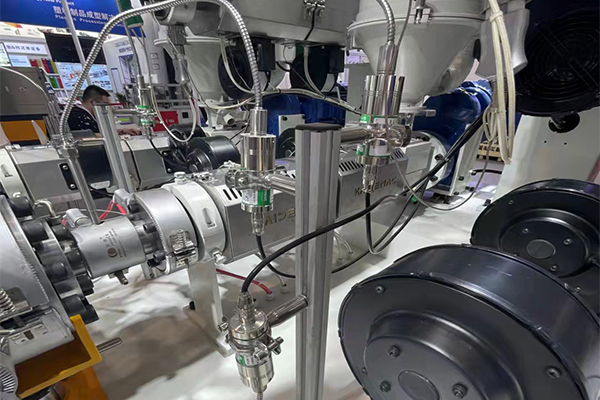In the extrusion production line, melt pressure transducers/transmitters play an important role in improving melt quality, improving production safety and protecting production equipment. At the same time, the melt pressure transducer/transmitter is a very sensitive component, and only proper installation and maintenance can make its function fully play.
In the extrusion production process, some product quality standards (such as dimensional accuracy or surface flatness of parts with mineral fillers, etc.) require optimized control of the extrusion pressure. The melt pressure melt pressure transducer/transmitter fulfills this requirement. Important components. By arranging a melt pressure transducer/transmitter and a pressure control device at the connection of the mold inlet, the yield can be more stable, and the waste of materials can be reduced at the same time. Melt pressure transducers/transmitters play an important role in improving melt quality, improving production safety, protecting production equipment and extending its service life.
In addition, measuring the pressure through the filter screen and the melt pump is also very important for ensuring the safety of production and optimizing the performance of the equipment. If the melt flow into the mold is blocked, the sensor under the filter screen will give an alarm to alert the operator. When the sensor on the filter screen sends out an alarm, it indicates that the internal pressure of the extruder is too high, which may cause excessive wear on the screw. For manufacturers using melt pumps, it is necessary to measure the inlet pressure and outlet pressure of the melt to ensure that the melt can continuously flow into the mold, because any obstruction may cause damage to the melt pump.
The melt pressure transducer/transmitter assembled on the extrusion production line can be a single sensor that only measures the pressure of one point, or a series of sensors used to measure the entire production line. The melt pressure sensor is connected with the data recorder and the sound alarm device, and the processing parameters of the extruder can be adjusted by the processing control system. At the same time, the pressure sensor is also a very sensitive component. If it is not properly installed and maintained, it is very easy to damage. The following simple methods will help prolong the service life of the pressure sensor and at the same time help users get accurate and reliable measurement results.
● Correctly install
Usually the damage of the pressure sensor is caused by its improper installation position. If the sensor is forcibly installed in a hole that is too small or a hole with an irregular shape, the diaphragm of the sensor may be damaged by impact. Choosing a suitable tool to process the mounting holes is conducive to controlling the size of the mounting holes. In addition, proper installation torque is conducive to forming a good seal. However, if the installation torque is too high, it is easy to cause the sensor to slip off. To prevent this phenomenon, usually apply anti-off compound on the threaded part of the sensor before installation. After using this compound, even if the installation torque is high, the sensor is difficult to move.
● Check the size of the mounting hole.
If the size of the mounting hole is not appropriate, the threaded part of the sensor will be easily worn out during the installation process. This will not only affect the sealing performance of the device, but also make the sensor not fully functional, and may even cause safety hazards. Only suitable mounting holes can avoid thread wear (thread industry standard 1/2-20 UNF 2B), and mounting hole measuring instruments can usually be used to test the mounting holes to make appropriate adjustments.
● Keeping the installation holes clean.
Keeping the installation holes clean and preventing melt blockage is very important to ensure the normal operation of the equipment. Before the extruder is cleaned, all sensors should be removed from the barrel to avoid damage. When the sensor is removed, the molten material may flow into the mounting hole and harden. If the residual molten material is not removed, the top of the sensor may be damaged when the sensor is installed again. The cleaning kit can remove these melt residues. However, the repeated cleaning process may deepen the damage to the sensor caused by the mounting hole. If this happens, measures should be taken to raise the position of the sensor in the mounting hole.
● Choose the right location
When the sensor is installed too close to the upstream of the production line, the unmelted material may wear the top of the sensor; If the sensor is installed too far back, there may be a stagnation zone of molten material between the sensor and the screw stroke, where the molten material may degrade and the pressure signal may be distorted; If the sensor goes too deep into the barrel, the screw may touch the top of the sensor during rotation and cause damage. Generally speaking, the sensor can be located on the barrel in front of the filter screen, before and after the melt pump, or in the mold.
● Clean carefully
All sensors should be removed before cleaning the extruder barrel with a wire brush or special compound. Because both cleaning methods may damage the vibrating film of the sensor. When the barrel is heated, the sensor should also be removed and the top of the sensor should be wiped with a soft cloth that will not cause wear. At the same time, the hole of the sensor should also be cleaned with a clean drilling machine and guide sleeve.
● Keep dry
Although the circuit design of the sensor can withstand the harsh extrusion environment, most sensors are not absolutely waterproof and are not conducive to normal operation in a humid environment. Therefore, it is necessary to ensure that the water in the water cooling device of the extruder barrel will not leak, otherwise it will have an adverse impact on the sensor. If the sensor has to be exposed to water or humid environment, it is necessary to select a special sensor with strong water resistance.
● Avoid low temperature interference
In the process of extrusion production, there should be sufficient "soaking time" from solid to molten state for plastic raw materials. If the extruder does not reach the operating temperature before starting production, the sensor and extruder will be damaged to some extent. In addition, if the sensor is removed from the cold extruder, the material may adhere to the top of the sensor and cause damage to the vibrating film. Therefore, before removing the sensor, confirm that the temperature of the barrel is high enough and the materials inside the barrel are softened.
● Prevent pressure overload
Even if the overload design of the pressure measuring range of the sensor can reach 50% (the ratio exceeding the maximum range), risk should be avoided as far as possible from the perspective of equipment operation safety. It is best to select the sensor with the measured pressure within the range. In general, the best range of the selected sensor should be twice the measured pressure, so that the sensor can be prevented from being damaged even if the extruder operates under extremely high pressure.




